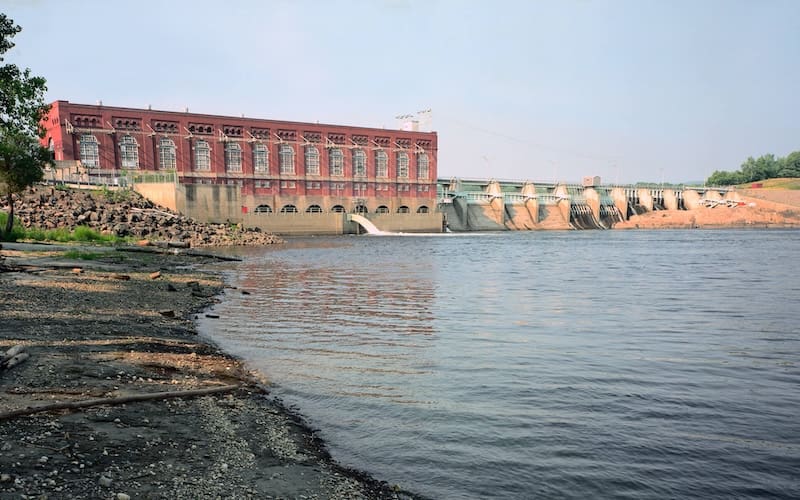
The Vernon Dam on the Connecticut River. Photo by Al Braden.
May 19, 2025 (Montpelier, VT) – Five environmental non-profit organizations filed an appeal of the Clean Water Act §401 Water Quality Certification (WQC) issued by the Vermont Department of Environmental Conservation (VTDEC) and three of them appealed the New Hampshire Department of Environmental Services (NHDES) for three hydropower facilities on the Connecticut River: the Wilder Dam, Vernon Dam, and Bellows Falls Dam.
“By applying a flawed standard in its certification, the State of Vermont fails to protect the Connecticut River and those who depend on it for clean water,” said Mason Overstreet, Conservation Law Foundation senior attorney. “Our region has experienced deadly and damaging floods in recent years and climate change will bring more intense storms, increased erosion, and heavier water flows. Yet, Vermont fails to take into account these critical impacts on water quality and river health. These licenses last for up to 40 years, making it even more vital that we get it right. We need to ensure dam operations can withstand a changing climate while safeguarding the river for generations to come.”
The organizations include the Connecticut River Conservancy, American Whitewater, Conservation Law Foundation, Vermont Natural Resources Council, and American Rivers. This follows a similar announcement just a few days ago in Massachusetts regarding the appeal of WQCs for two other hydropower facilities. The WQCs for all five hydropower facilities undergoing relicensing on the mainstem of the Connecticut River—in New Hampshire, Vermont, and Massachusetts—are now being challenged.
The Water Quality Certification refers to Section 401 of the Clean Water Act in which a federal agency (in this case the Federal Energy Regulatory Commission – FERC) may not issue a license to hydropower facilities with a discharge into public waters unless the state waives the certification requirement or issues a WQC certifying that the operation of the facility will comply with and be protective of existing water quality standards.
“The states have a responsibility to uphold water quality and protect the public trust resource that is the Connecticut River,” said Kathy Urffer, Director of Policy and Advocacy and Vermont River Steward at the Connecticut River Conservancy. “Given that these licenses will last for the next 30 to 50 years, we’re taking this action to ensure they take that responsibility seriously.”
The non-profits claim that the WQCs fall short in the following significant ways: by not requiring an enforceable and detailed plan to require recreational access; by failing to require timely and sufficient upstream and downstream fish passage; by failing to sufficiently address erosion impacts from the dams; by failing to address invasive species, by failing to sufficiently protect the state and federally listed endangered shortnose sturgeon; by largely ignoring the current and worsening impacts of climate change; and, in the case of NH, by failing to provide for meaningful public comment.
“New Hampshire has an obligation under the Clean Water Act to make sure that these hydropower dams will not diminish the public’s ability to use and enjoy the Connecticut River for recreation,” said Bob Nasdor, American Whitewater Northeast Stewardship & Legal Director. “The state has utterly failed to do that here.”
After over a decade of research, documentation, submission of public comments, and a thorough review of both the application and draft WQCs, the non-profits contend that conditions proposed by VTDEC and NHDES in their final Water Quality Certifications are not sufficiently protective of the water quality, ecosystems, and recreational resources spanning over 150 miles of the Connecticut River affected by these three dams, as required by law. The Connecticut River Conservancy (CRC) and co-appellant non-profits commented on the application, the draft §401 WQC, and reviewed the final WQC. After determining that the state agencies did not follow the law in both VT and NH, and that the water quality standards would not be met by the conditions in the final certifications, CRC and partners filed appeals in both states.
Any conditions required in the states’ WQCs will be included in the 30 to 50 yearlong licenses granted by FERC. It has been 13 years since the hydropower relicensing process began, and once issued, the new license will regulate facility actions for a generation.
In Vermont, the state said that there was “reasonable assurance” that water quality standards would be met, rather than the “will comply” standard required by law.
As required by the Federal Clean Water Act and the Vermont and New Hampshire Surface Water Quality Standards, water quality in rivers must support designated and existing uses, which include water quality parameters such as turbidity and nutrient loads, aquatic life and its habitat, and water related recreation (e.g., boating, swimming). With the Connecticut River already being challenged with habitat loss, severe flooding, excessive bank erosion, and outdated recreation amenities, it is imperative that the states exercise their authority to protect water quality and the public’s use of the river from adverse impacts from the dams.
CRC has been advocating since 2013 for the strongest possible license to support a healthier river over the coming decades. The conditions that Vermont and New Hampshire place in this WQC are the primary way for the states to protect this shared resource for many years to come. Without strong protective conditions in their WQCs, the states are failing to protect existing water quality, let alone enhance the quality of water as mandated by their own regulations.
“We all deserve healthy water, thriving aquatic ecosystems, and recreational access on our rivers,” said Lauren Hierl, executive director of Vermont Natural Resources Council. “Today’s action helps protect these vital resources for current and future generations by ensuring this project complies with state and federal water laws for decades to come.”
Experts are available for further comment.
###
